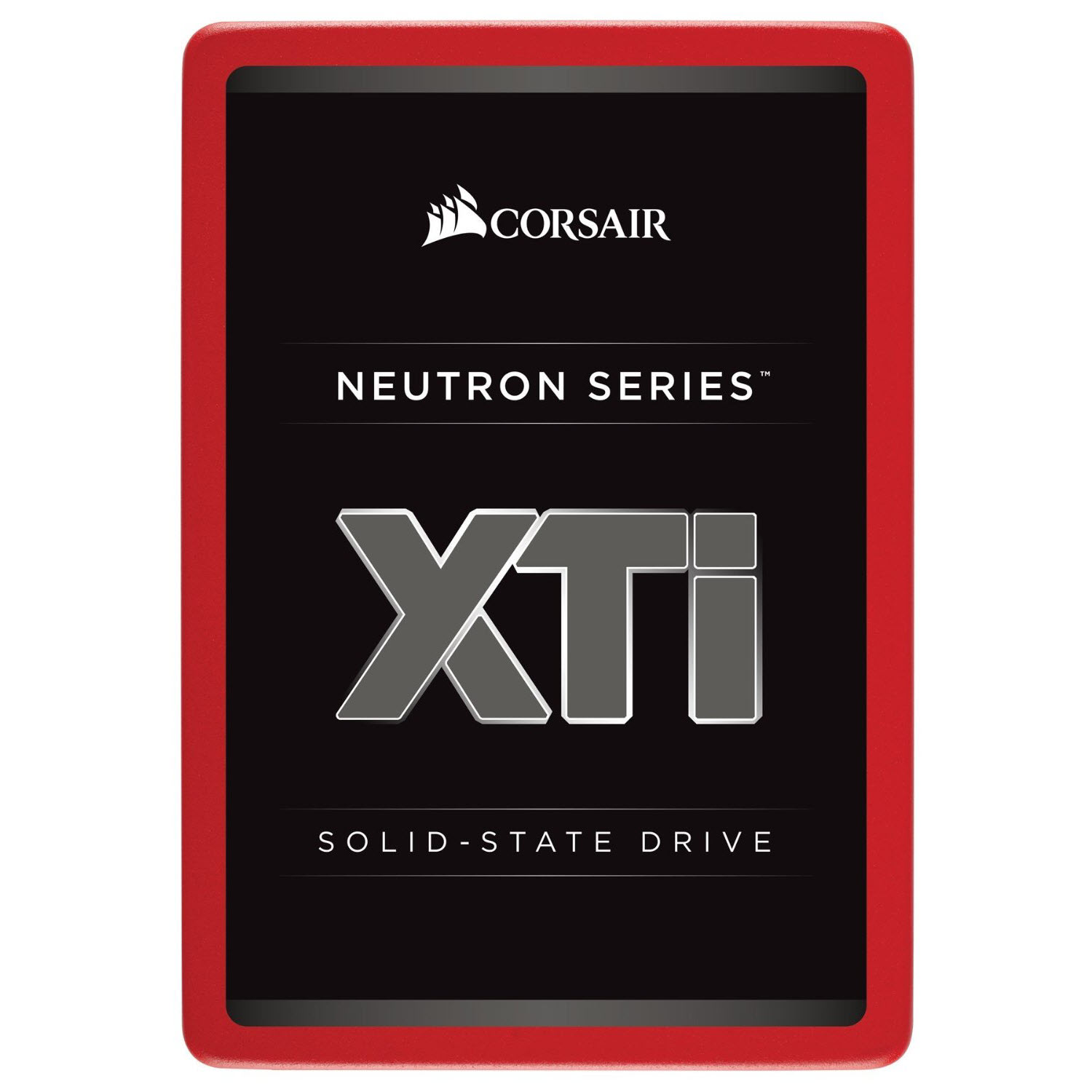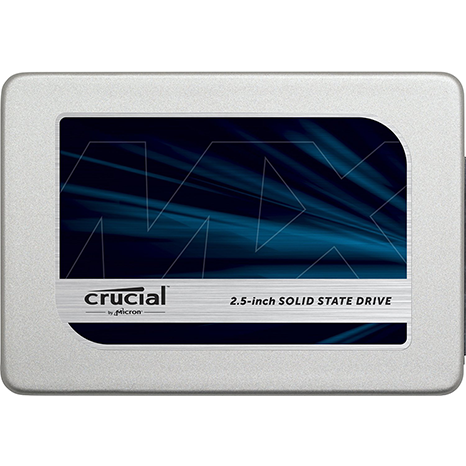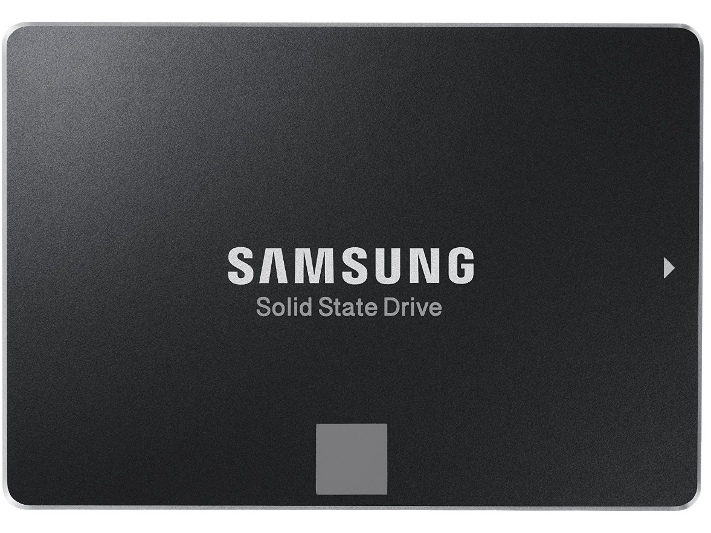Toshiba OCZ VX500 SSD Review
Why you can trust Tom's Hardware
Comparisons And Synthetic Benchmarks
Comparison Products
We rarely use the performance SATA charts, and the latest test pool is quite a bit different than the last time we covered a new SATA SSD. Crucial replaced the MX200 with the new 3D-enabled MX300 and Corsair's Neutron XTI now represents the best of the Phison S10 products. The XTi is the first SSD to feature Phison's Double DDR technology, which uses twice as much DRAM for the Flash Translation Layer (FTL).
Three products carry over from the previous test selection. The Samsung 850 EVO represents the best of the mainstream market. At one point, the EVO was just a few dollars more than low-cost entry-level products, but the price has crept up over the last few months while TLC-enabled products like the OCZ Trion 150 have dropped. The large gap makes the EVO a true mainstream, mid-tier product. The Samsung 850 Pro and SanDisk Extreme Pro represent the best performance that SATA has to offer. Both drives ship with a 10-year warranty and deliver exceptional performance during moderate and heavy workloads. The Toshiba VX500 aims to challenge these products while undercutting both on price.
We have three of the four Toshiba OCZ VX500 products and compare them to 512GB-class SSDs. The heavy black bar in the chart identifies the VX500 512GB. The VX500 256GB and 1TB are also in the test pool, but we will focus our commentary on the 512GB model.
Sequential Read Performance
To read about our storage tests in-depth, please check out How We Test HDDs And SSDs. Four-corner testing is covered on page six of our How We Test guide.
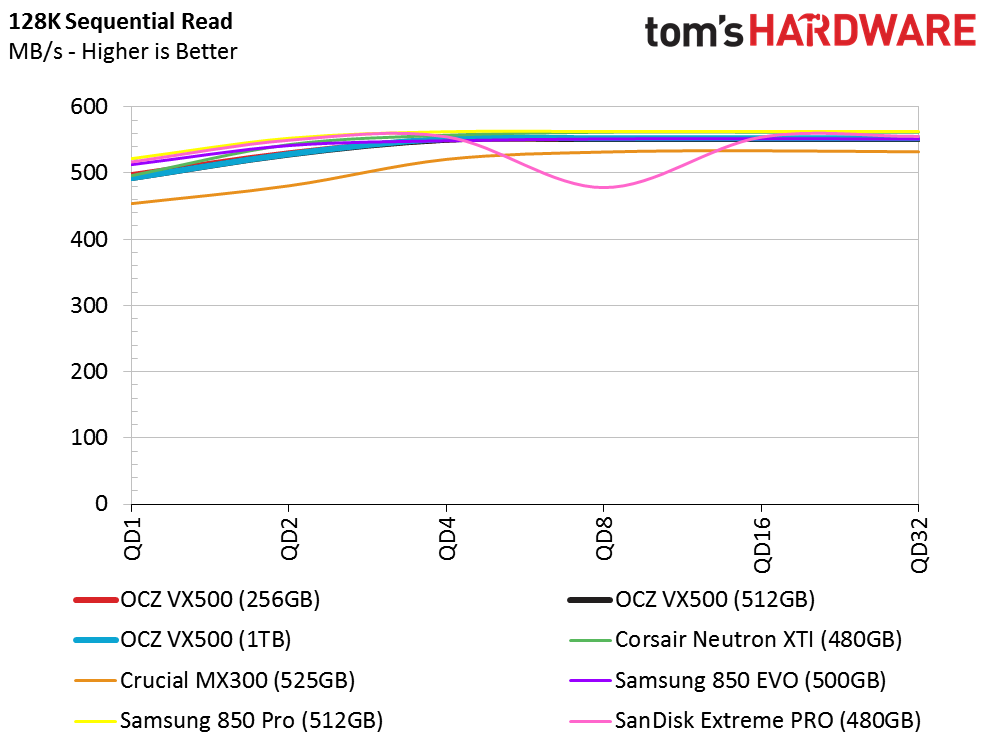
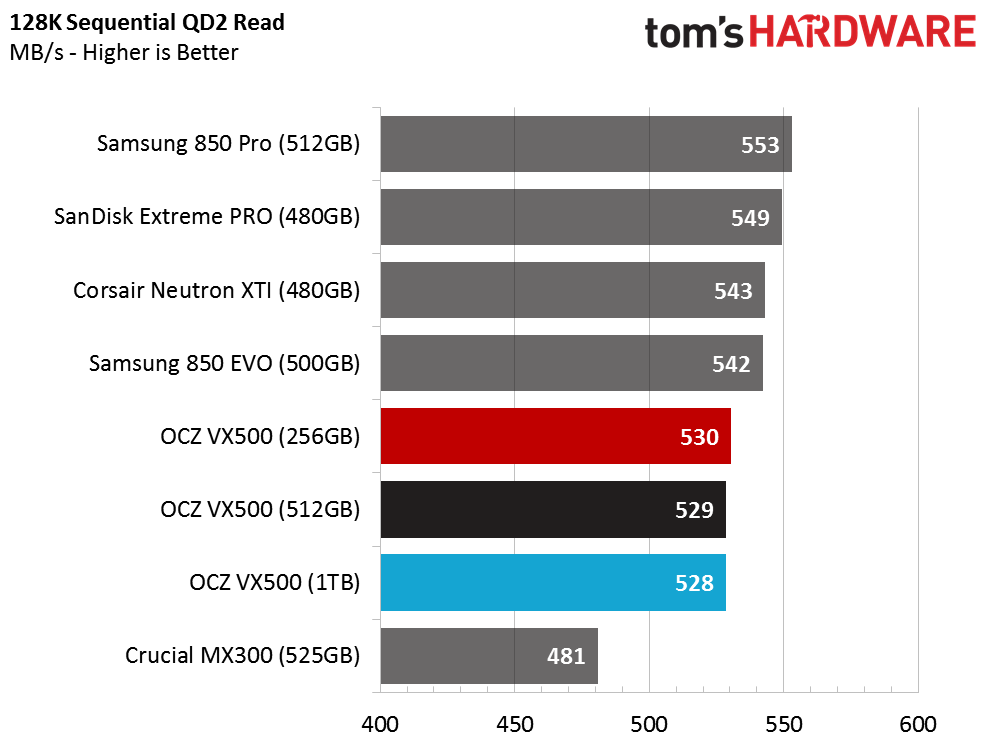
The sequential read performance test reveals that the products fall into distinct performance bands at QD2. The only product with a serious disadvantage is the Crucial MX300, which Micron outfitted with its new 384Gbit 3D TLC flash. Crucial still positions the MX300 series for the mainstream market, but the hefty die density results in decreased performance at smaller capacities. The 3D flash comes alive in large capacities over 1TB, though.
The VX500 fares better than the MX300, but it still trails the other products. The two market leaders deliver roughly 20 MB/s more performance at QD2 than the competitors. The difference looks significant on paper, but under real-world conditions, the extra performance equates to a rounding error in the amount of time it takes to transfer a medium-sized file.
Sequential Write Performance
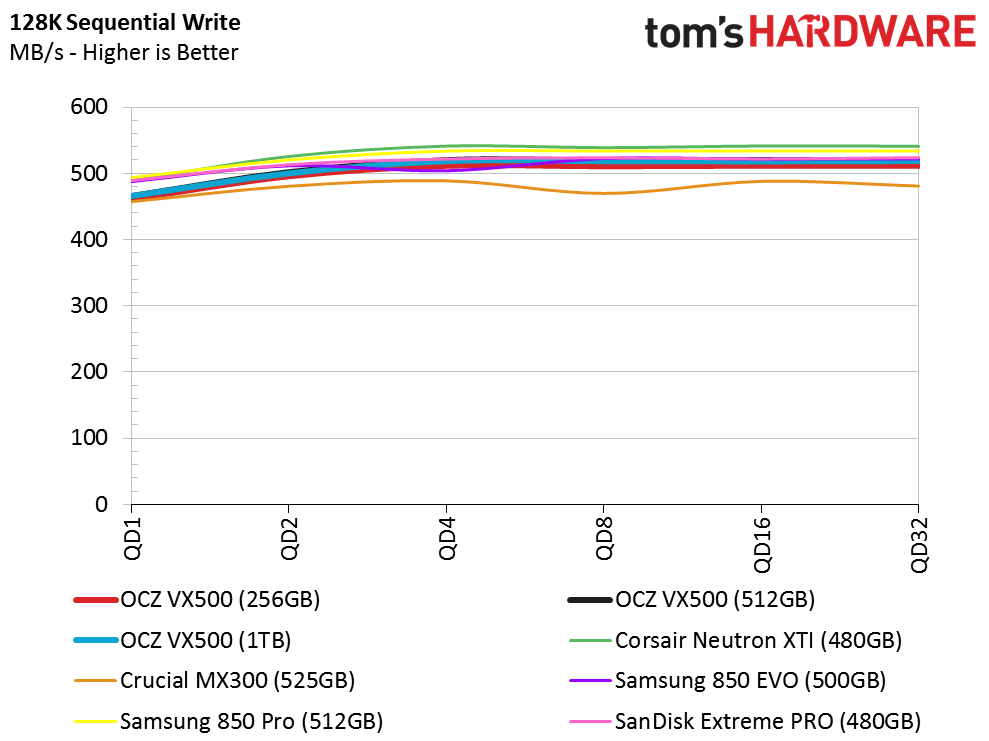

The sequential write charts also reveal different performance bands, and the humble Neutron XTI takes the podium while the Samsung Pro and EVO models trail close behind. The three VX500 drives reach 500 MB/s at QD2. We expected a little more separation between these three drives, but they all perform about the same with sequential data.
Random Read Performance

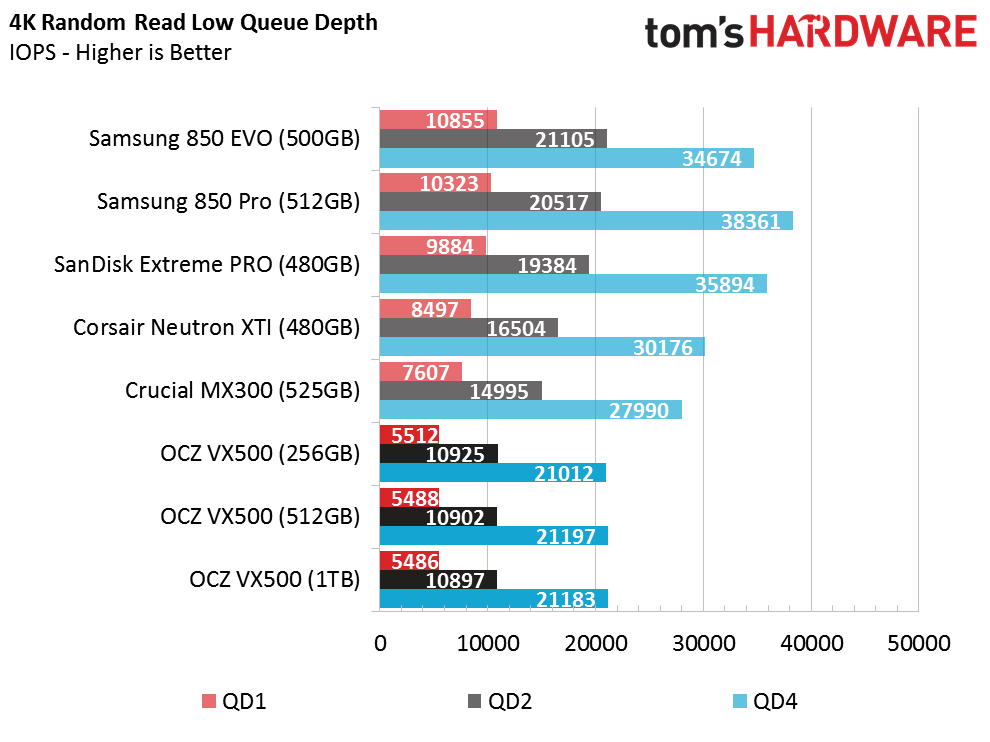
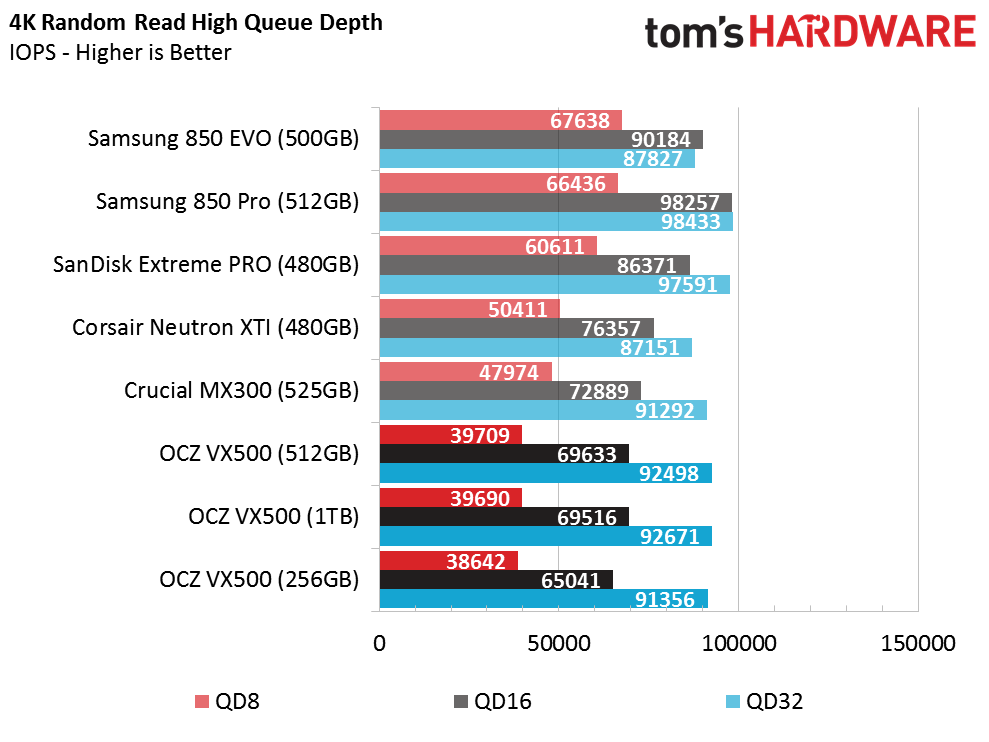
All three VX500 SSDs deliver abysmal random read performance. When I compiled the charts, I started to doubt if it was appropriate to compare the VX500 to the high-performance models. Later in the review, we will see a total 180-degree change during real-world applications. Toshiba's programming always gives us odd results in synthetic workloads, and it's been a long time since we've tested a Toshiba SATA SSD with a DRAM buffer. We've pinned the low random performance on the bufferless configuration used with the previous products, but there is more to the story.
The VX500 has a small DRAM or SRAM buffer to cache the LBA map, but the cache is not large enough to hold the map in its entirety. Toshiba likely uses algorithms to detect "hot" data on the drive, and then only caches the frequently accessed portions of the map. This technique allows the SSD to provide fast performance with frequently accessed and localized data, which is very common with applications, but performance suffers when requesting "cold" data (which can happen during synthetic benchmarks).
Random Write Performance

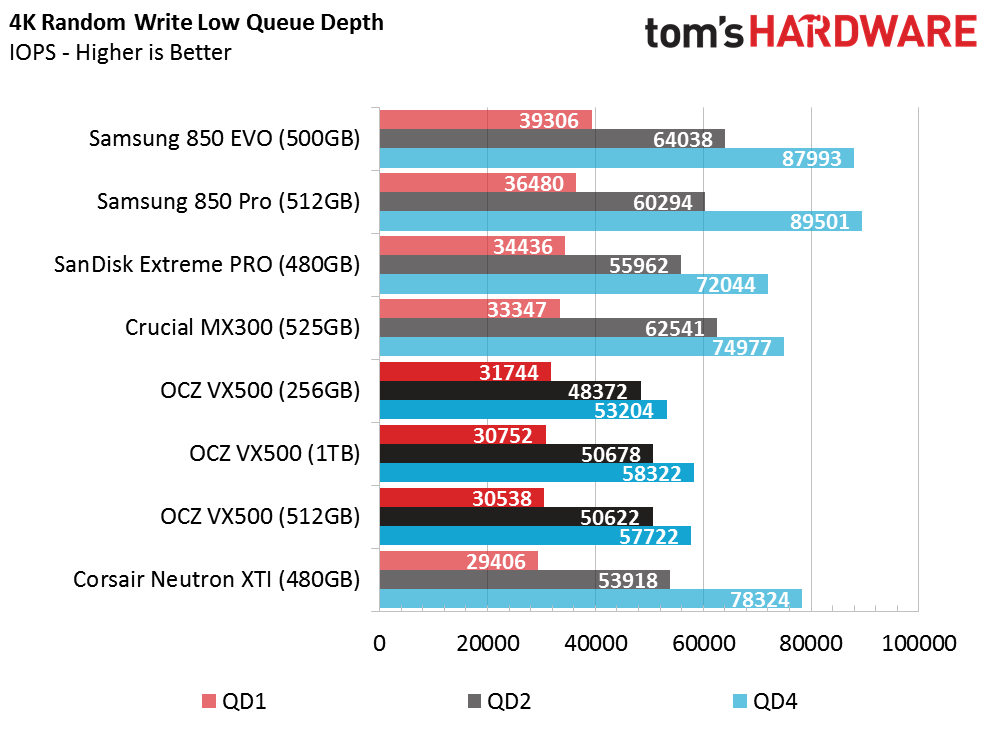

OCZ's VX500 specifications already tipped us off to expect low random write performance, but we didn't expect the low peak performance to drag down the low-QD performance, too. Toshiba will have a few hurdles to overcome with firmware tuning. Toshiba designed many of its SSDs for the OEM market where the biggest selling point is capacity and pricing. Retail products, especially anything from OCZ, come with additional performance scrutiny. Toshiba will need to listen to the team it acquired to gain insight into designing and selling high-performance products for the upgrade market.
80 Percent Sequential Mixed Workload
We describe our mixed workload testing in detail here, and describe our steady state tests here.

As mentioned, Toshiba client SSDs are much better than what the synthetic tests lead us to believe. The VX500 tackles sequential mixed workloads with ease and outperforms the competition. The results tell us that Toshiba isn't tuning for synthetic tests and is focusing on application performance instead, which is where optimizations really matter.
80 Percent Random Mixed Workload
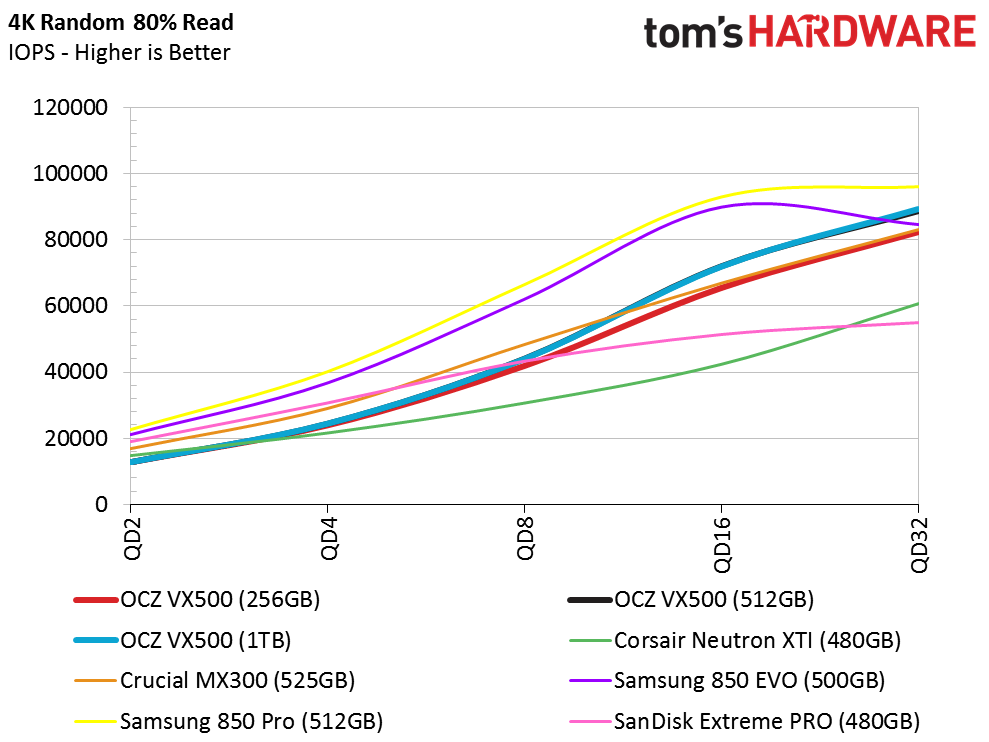
The VX500 would lead another mixed workload test, but this time with random data, if we removed the two high-cost Pro SSDs. We would like to see the VX500 take it to the next level and compete with the two Pro products, but the low random read performance makes it a difficult task. A product can only start out with so much of a disadvantage before it gets to a point where catching up is impossible.
Sequential Steady-State
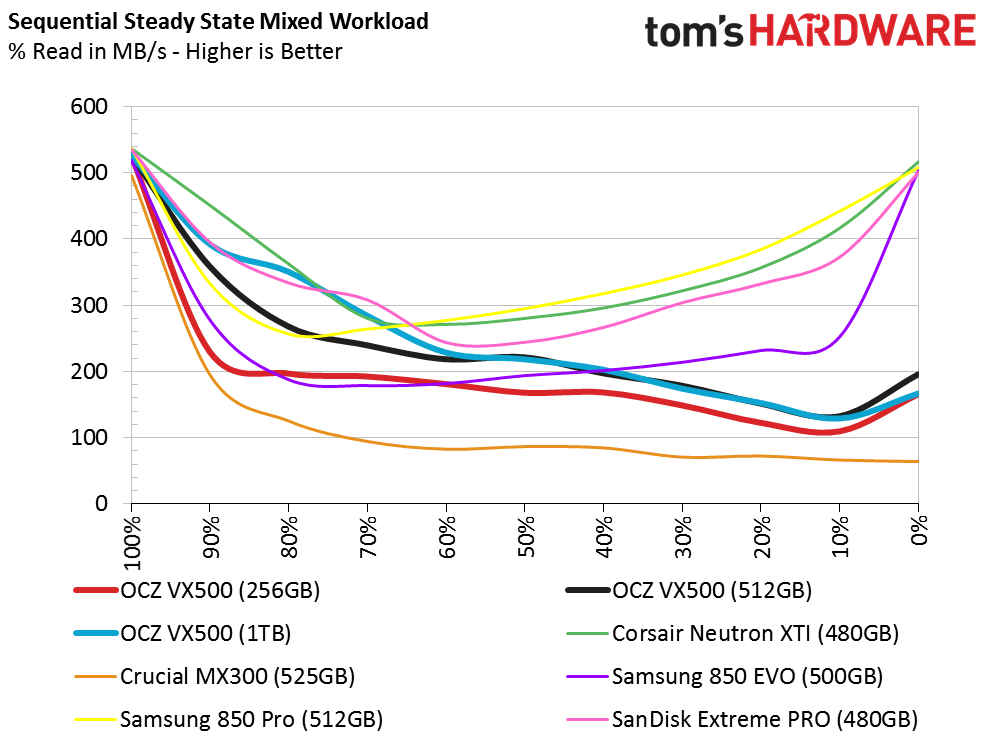
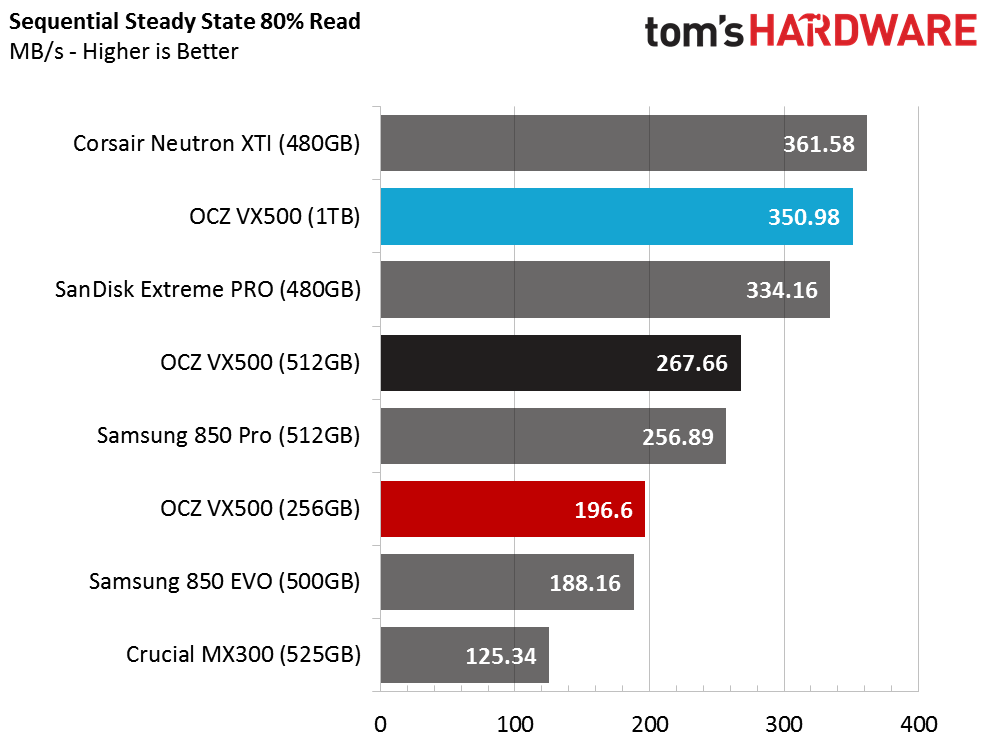
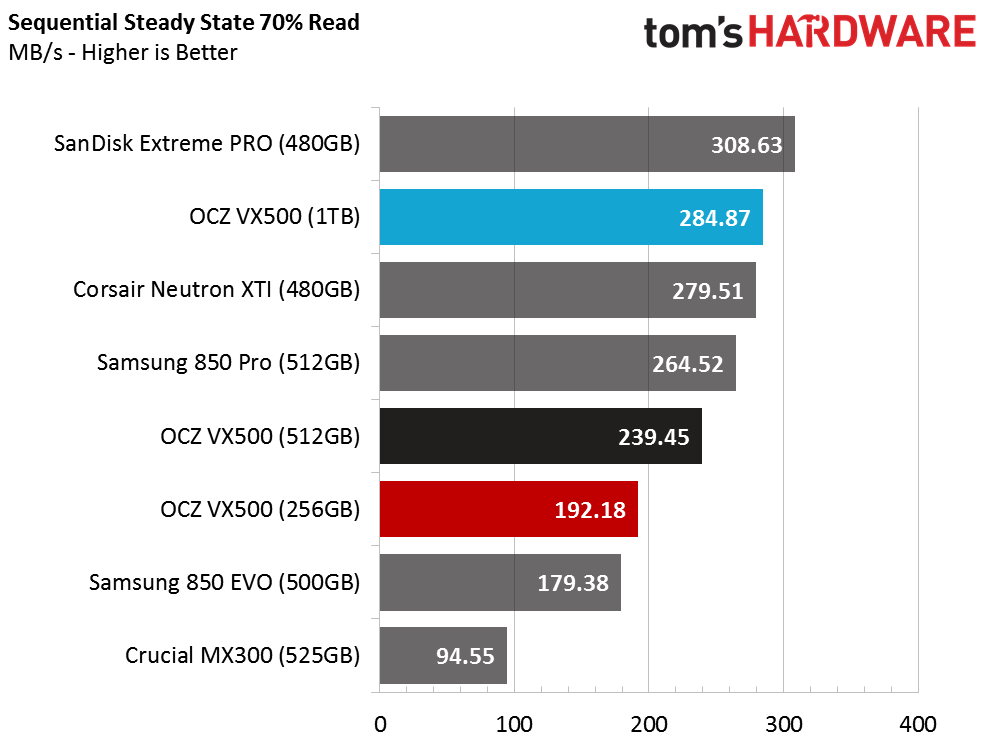
The three VX500 SSDs share nearly identical performance specifications, but larger capacity drives from the same family will almost always deliver higher performance. The bigger drives use larger DRAM buffers and more NAND, and that helps speed up performance. The VX500 512GB performs well compared to the other products in the chart. It doesn't outperform all of the drives in the sequential steady state tests, but it makes its mark in the middle of the field.
Random Steady-State

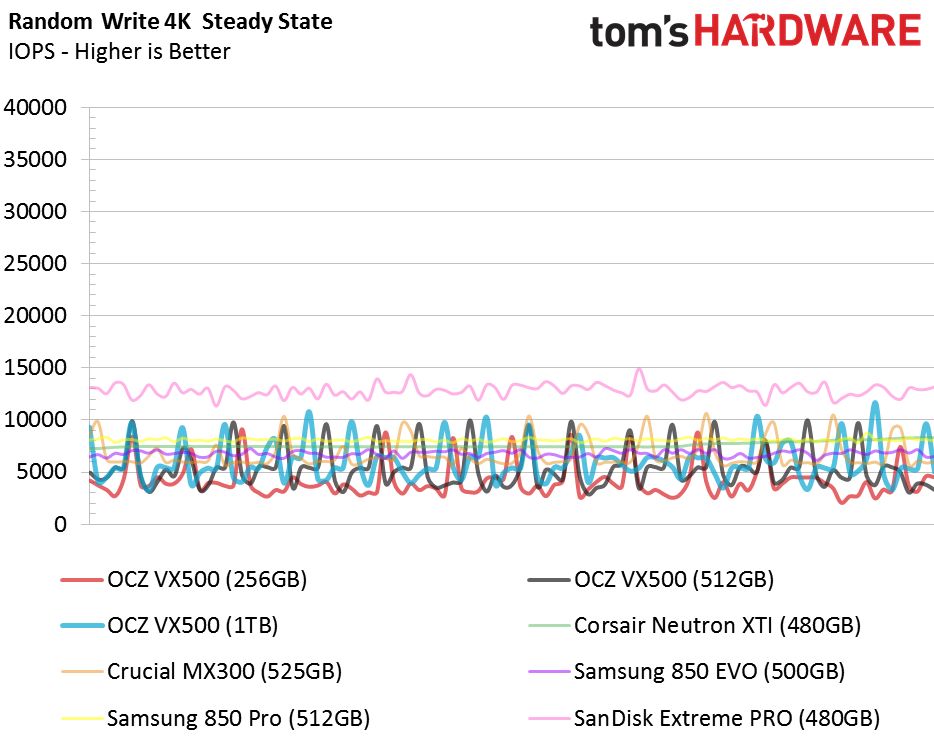
Performance consistency is what makes the SanDisk Extreme Pro stand out from the crowd. The drive also has high peak performance when we push it hard. The OCZ VX500 series has less consistency and a wider gap between its highest and lowest performance during the test. When you contrast the two we see what we are looking for, and also what we don't want to see. The VX500 has the widest performance variation of the drives tested, but it still performs much better than any of the TLC-based products (other than the 850 EVO). The VX500 series deserves comparison to the best SATA SSDs on the market, but it doesn't always come out on top of this group of powerful SSDs.
MORE: Best SSDs
MORE: Latest Storage News
MORE: Storage in the Forums
Current page: Comparisons And Synthetic Benchmarks
Prev Page Specifications And Features Next Page Application PerformanceGet Tom's Hardware's best news and in-depth reviews, straight to your inbox.
-
Dan2357 Hey Tom's (&Chris) great work with the ssd reviews! Between this and the PM961 review yesterday you guys are really putting out the sort of content I come here to see. Just wanted to say thanks and keep it up!Reply -
Zaxx420 Like many others, I cut my teeth on Ocz drives back 'in the day'...lol Learned a lot of what I know about SSDs on their once awesome community forum. They had the balls to light the way for everyone else when SSDs were in their infancy. And ofc being first carries risks...Ocz took a beating trying to sort out Sandforce's firmware nightmare(s) but ultimately someone had to take one for the team. I'd hate to see the Ocz name and more so the Ocz spirit get absorbed into obscurity. Fingers crossed that Ocz can come out guns blazin' when Tosh finally gets BiCS to market. Lord knows they have the resources to duke it out with Samsung at the top but as it sits they are more focused on the more lucrative enterprise market.Reply -
ssdpro In defense, consumers that feel "No 3D, no sale" are victims of marketing magic. You will never experience the difference between planar mlc and "3D" in a high performing SATA device.Reply
But the negative, quoted directly from the article: "I really hope the OCZ portfolio doesn't turn into a rebranded version of Toshiba's OEM and retail products with a new package, sticker and software access. Is this what OCZ has become?"
At this point, it appears that is what it HAS become. Also, as of right now, from the moment this review and others went live OCZ still hasn't listed this product on their website (will change I am sure but sums up their organization). -
Design1stcode2nd Maybe I'm missing something but the real world application graph is what I'm focusing on. It just confirms for me that your average user or gamer will see no real difference in a SATA SSD so go for a TLC or 3D TLC version. I'm probably going to end up with a Trion 150, I just don't see the need to go with an 850 or 850 pro for my use case. By the time the warranty runs out I'll likely have a new Mobo, CPU and be using NVME M/2 anyway. It will also probably be larger capacity for less money as well.Reply -
Modus27 Given the barely noticeable real world differences, I'd take this over Samsung 850 EVO at current MSRP just based on endurance. How did that not make it into a PRO, when you said that was only advantage it had?Reply -
abbadon_34 5 Year warranty? Sold.Reply
In this time dwindling warranties (my recent 8TB Seagate has a 1 year warranty) and the warning given by Kevin Chen about DRAMless going to 12 months this is music to my ears and solid belief in their products.
http://www.tomshardware.com/news/kevin-chen-adata-ssd-industry,32050.html -
mapesdhs I know this review naturally focuses on newer products, but it would be nice to include a couple of older OCZ mainstream models, and even an older top-end model, just to see whether "OCZ" products really have improved compared to what was current not that long ago. Any chance you could add an Arc 100, Vector, Vertex4? Sometimes I feel that SSD reviews tend to do what happens in GPU reviews, not enough comparison across historial timelines to show what the long term trends really are.Reply
Alas, in this case, once again I think price is going to be the deciding factor, and OCZ's more recent products have been consistently too expensive. Shame really, I bought a lot of their older models and am very happy with them, but after the Arc came out their pricing just went up and up, to the point where typical sellers had the Arc 100 listed for more than an 850 EVO, which is nuts. Many never bothered listing the Vector 180 at all.
Btw Chris, please fix those graphs! ;D
Ian. -
CRamseyer I'm limited by how much space I have for the charts. 8 Products is the max for the charts. I would love to increase the comparison depth but I can't. I have nearly ever consumer SSD released since this category started. I would love to release a set of charts with hundreds of drives.Reply -
TMRichard Chris, what I would be really interested in seeing with your test data is an interactive 'chart' which allows us to select the drives want to compare it to. Even if it still maxes out at 8 items that would be more that sufficient. I know there are other sites that will allow us to do this but I would like to know I'm using a reliable, trustworthy set of test data so I can make an informed decision on the item.Reply -
mapesdhs Reply18595925 said:I'm limited by how much space I have for the charts. 8 Products is the max for the charts. I would love to increase the comparison depth but I can't. I have nearly ever consumer SSD released since this category started. I would love to release a set of charts with hundreds of drives.
Perhaps a different chart format? Or a selectable list as TMRichard describes?
Ian.
